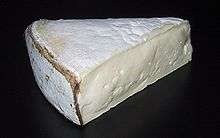Vacherin
| Vacherin | |
|---|---|
 | |
| Country of origin | France, Switzerland |
| Region, town | Franche-Comté, Vallée de Joux, Fribourg canton |
| Source of milk | Cows |
| Pasteurized | Traditionally, no |
| Texture | washed rind soft cheese |
| Aging time | 5-7 weeks |
| Certification |
AOC France 1981; |
|
| |
Vacherin is a cow's milk (French vache, "cow") cheese. Two main types of French or Swiss Vacherin cheeses exist.
Mont d'Or

One type of Vacherin cheese is called Mont d'Or, or Vacherin du Haut-Doubs, from France,[1][2] or Vacherin Mont d'Or from Switzerland[2][3] (though it tends to just be called Vacherin in the local shops). It is a soft, rich, seasonal cheese made from cow's milk in Switzerland or France, usually in villages of the Jura region (an origin that has been officially controlled since 1981), and has a grayish-yellow washed rind. It typically contains 45 to 50 percent milk fat (in dry matter), and is produced between August 15 and March 15, and sold between September 10 and May 10. The Swiss Vacherin Mont d'Or is generally made with thermized milk (pasteurization is not allowed), while the French Vacherin du Haut-Doubs is unpasteurized.[3][4] It is traditionally made in the winter months when the cows come down from Alpage (mountain pastures) and there is not enough milk to make Comté cheese.[5] And when the cows are kept undercover & fed exclusively on Hay & not fresh grass. It is marketed in round boxes of various diameters made of spruce.[6] The strips of spruce are harvested by specialists called "sanglier".[7] It is often served warmed in its original packaging and eaten like fondue.
Officially, the French AOC/PDO allows Artisanal and Coopérative production of Mont d'Or.[1] There are 11 producers of Vacherin in France (2009).[5]
Vacherin Fribourgeois
The other Vacherin, a firmer Swiss cheese, is called Vacherin Fribourgeois. It is produced under Swiss AOC in the Fribourg canton, where Gruyère also originates.[2][8] It has a slightly acidic, resiny flavor, akin to Italian Fontina,[3][8] with a varying strength depending on the age and type. It is also a basic component lending character to fondues (depending on the recipe). Vacherin Fribourgeois has Swiss AOC status with 6 varieties being available:[9]
- Classic (aged: 6–12 weeks)
- Extra (aged: minimum 12 weeks)
- Rustic (aged: minimum 12 weeks, but up to 25 weeks (6 months))
- Alpage (aged: 12–25 weeks)
- Mountain (aged 9–25 weeks)
- Bio (Organic) (aged: minimum 9 weeks)

Vacherin d'alpage
Vacherin d'alpage is made from the milk of cows pasturing in alpine meadows and hence has a much richer taste. The older the vacherin gets, the stronger the smell of ammonia due to microorganism activity in the cheese.
See also
Notes and references
- 1 2 'French Cheeses' , DK, ISBN 1-4053-0666-1
- 1 2 3 'Cheeses of the World' , RolIand Barthelemy; Arnaud Sperat-Czar, (2001) ISBN 1-84430-115-X
- 1 2 3 "BBC Good Food - Vacherin Profile". Retrieved 28 November 2016.
- ↑ "Practically Edible - Mont d'or Profile". Archived from the original on 31 August 2010. Retrieved 28 November 2016.
- 1 2 "Mont d'Or ou Vacherin du Haut-Doubs". inao.gouv.fr. Retrieved 23 February 2015.
- ↑ Denis Bonnot, Le Vacherin Mont d'Or Franco-Suisse; un fromage qui sort du bois & du froid. Lons-le-Saunier (France), Areopage, 2006, p. 133
- ↑ Alamy Limited. "France, Doubs, Frasne, Forest, Sanglier Reaping The Straps On A Stock Photo, Picture And Royalty Free Image. Pic. 70394886". Alamy. Retrieved 23 February 2015.
- 1 2 'The Cheese Companion' , Judy Ridgeway, ISBN 1-84092-339-3 (2003)
- ↑ Vacherin Fribourgeois - Website (French)/(German) (accessed 02/Jan/2007)
External links
| Wikimedia Commons has media related to Vacherin Mont-d'Or. |
| Wikimedia Commons has media related to Mont d'Or. |
- Vacherin fribourgeois in the online Culinary Heritage of Switzerland database.
- Vacherin Mont d'Or in the online Culinary Heritage of Switzerland database.
- Making Vacherin Fribourgeois in a Swiss Alpine chalet over wood fire - photoreportage in English
- Vacherin Fribourgeois product page from The Red Cow, Australia